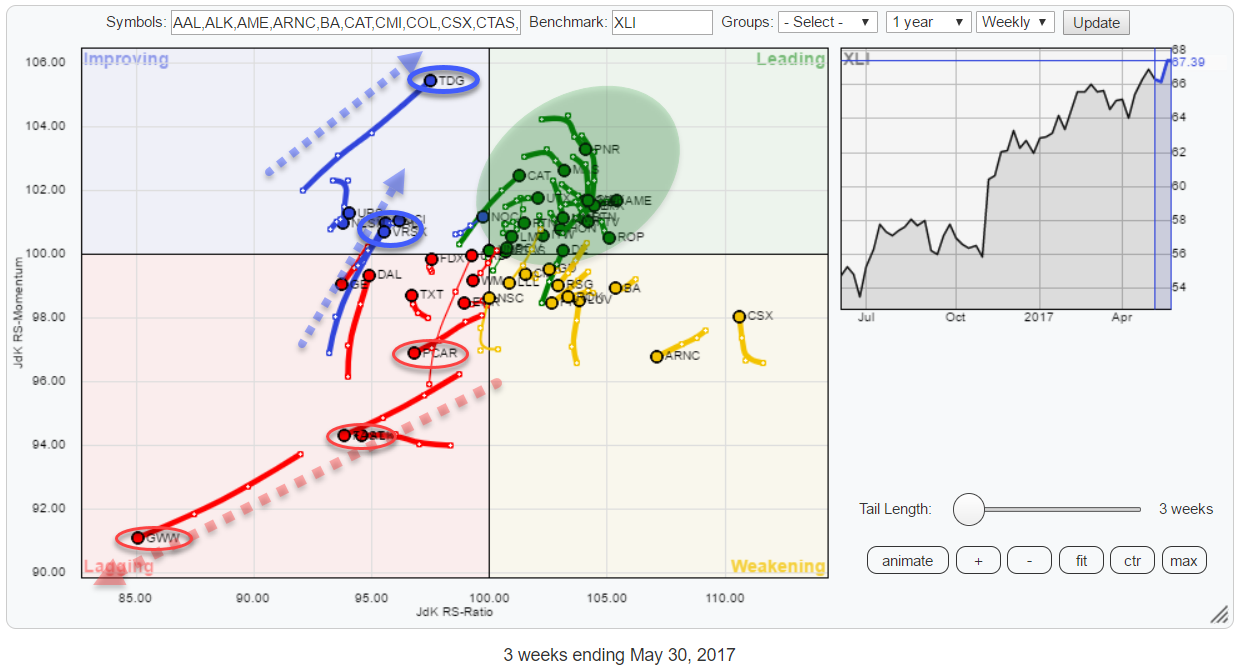 This Relative Rotation Graph holds the top 50 (based on market cap) members of the S&P 500 Industrials sector index (XLI). This sector accounts for just over 10% of the S&P 500 market cap and is the fifth largest sector in this index. At the moment it does not seem to get the attention it might be deserving.
This Relative Rotation Graph holds the top 50 (based on market cap) members of the S&P 500 Industrials sector index (XLI). This sector accounts for just over 10% of the S&P 500 market cap and is the fifth largest sector in this index. At the moment it does not seem to get the attention it might be deserving.
In the chart above a few stocks immediately catch the attention.
Very clearly in the lagging quadrant, we see GWW shooting further down into negative territory on a 225 degree RRG-Heading. Just behind it are PCAR and FAST at similar headings. The are all losing value on both axes at the same time and have relatively long tails.
In the improving quadrant, TDG stands out at the highest JdK RS-Momentum value in the universe but also AAL shows a positive heading and long tail which makes it worth looking at.
The green shaded area is a bit too crowded to inspect in this setup and needs to be zoomed in on which I will do further down.
Summary
- Industrials sector close to benchmark and hardly noticed
- Rotation towards positive RRG-Heading sparks interest
- GWW and PCAR are better avoided as they continue their rotation into lagging
- NOC picking up pace again
- AME, CAT, and DE leading the sector higher
From a sector perspective
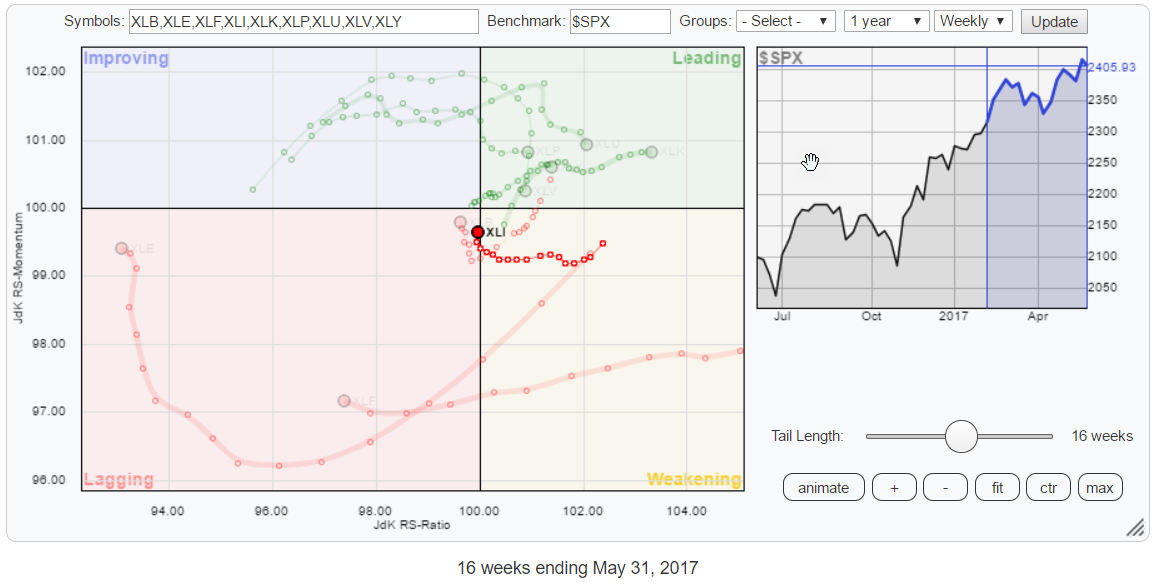 At sector-level, shown in the RRG above, the Industrials sector (XLI) is very close to the benchmark. As this indicates a trend in relative performance which is more or less in line with the benchmark, this is probably the reason why the sector has not been on the radar for many investors.
At sector-level, shown in the RRG above, the Industrials sector (XLI) is very close to the benchmark. As this indicates a trend in relative performance which is more or less in line with the benchmark, this is probably the reason why the sector has not been on the radar for many investors.
What makes XLI interesting from an RRG perspective is the recent turn up on the RS-Momentum scale which causes the (short) tail to move almost vertically higher after a series of weekly observations that are all very close together.
Zooming in
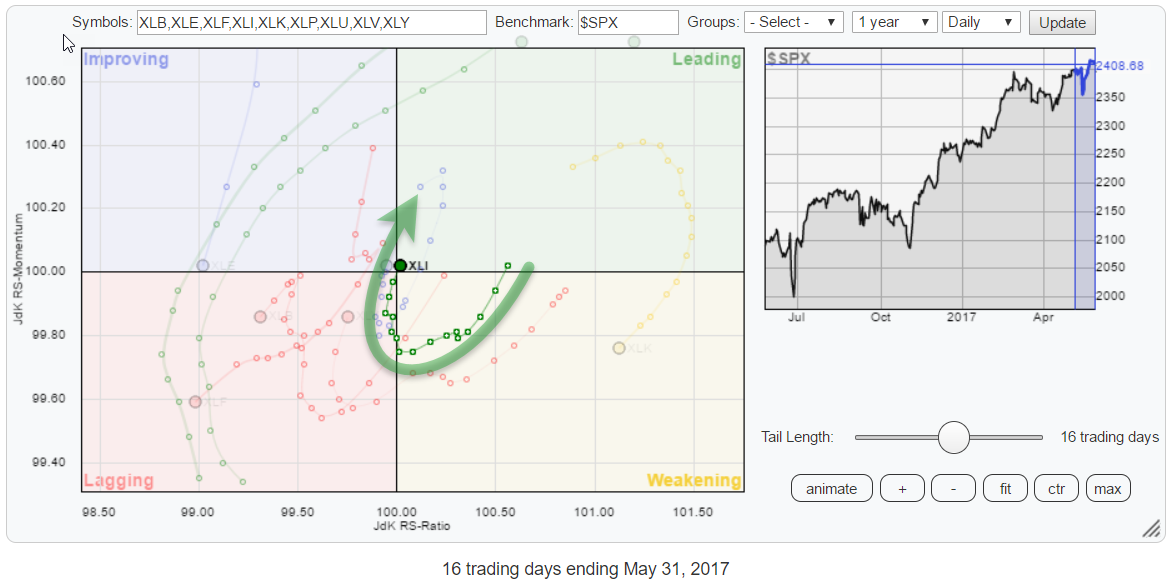 Zooming in, to the daily time frame at sector-level. Shows an almost similar rotation as seen on the weekly version. Two time-frames confirming each other direction is always interesting.
Zooming in, to the daily time frame at sector-level. Shows an almost similar rotation as seen on the weekly version. Two time-frames confirming each other direction is always interesting.
Reason enough to dive a little deeper into the composition of the Industrials sector and see if we can find a few names that can make a difference by being present in a portfolio or, equally or more important, by NOT being present in a portfolio.
Stocks to avoid
On the first RRG at the top of this article, I highlighted a few stocks inside the lagging quadrant that continue to move lower on both axes. These are prime candidates to avoid in a portfolio.
WW Grainger Inc. - GWW
 After testing resistance around $ 250, GWW started to fall sharply and crash every support level on its way down in a matter of weeks. Needless to say that this does not make for a strong chart.
After testing resistance around $ 250, GWW started to fall sharply and crash every support level on its way down in a matter of weeks. Needless to say that this does not make for a strong chart.
The effect on the relative charts started to become visible at the beginning of April when the RS-Line convincingly broke out of its range, which was visible during all of 2016. At the same time, both RRG-Lines dropped below 100 almost simultaneously, and at the moment, the JdK RS-Ratio line is at its lowest level in five years without any improvement likely at short notice.
One could argue that GWW is now hitting support around $ 170, and RRG-Lines are at extreme levels which is all true, but I prefer to see at least a small turn higher on the tail before getting my "buying binoculars" out. And even then, the (relative) damage done to this stock over the past few months needs a lot more time to repair before it can turn back into a decent relative uptrend.
Paccar Inc. - PCAR
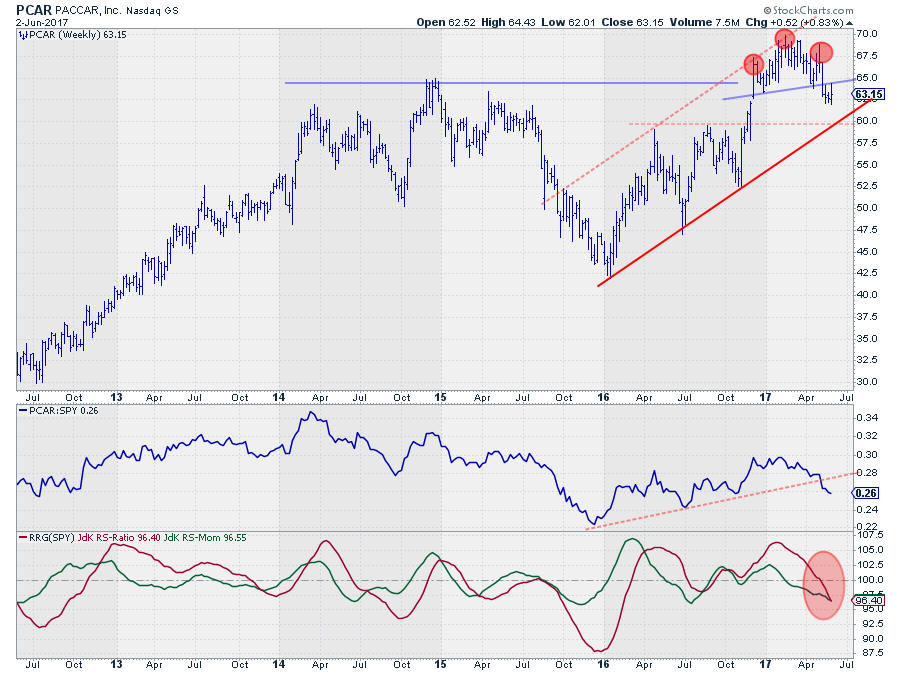 One of the other weak stocks inside the lagging quadrant is PCAR.
One of the other weak stocks inside the lagging quadrant is PCAR.
The relative charts are already flashing negative signals. The RS-Line has broken its rising support line while the RS-Ratio line has now followed the RS-Momentum line lower below 100 and both are still dropping.
On the price chart, there is still a rising channel visible that is intact. However, the price action since the beginning of this year had taken the form of a Head & Shoulders reversal that was completed when price broke below the neckline.
This break below the neckline coincided with PCAR breaking back below its former resistance level near $ 65, after failing to continue higher after the initial upward break. This is usually a sign that the market has tried but could not get enough buying power for a follow through rally and has now made up its mind starting to push price lower.
A break below double support coming off the rising support line and the 2016 peaks, will definitely confirm the weakness in PCAR and cause an acceleration in the decline.
Potential
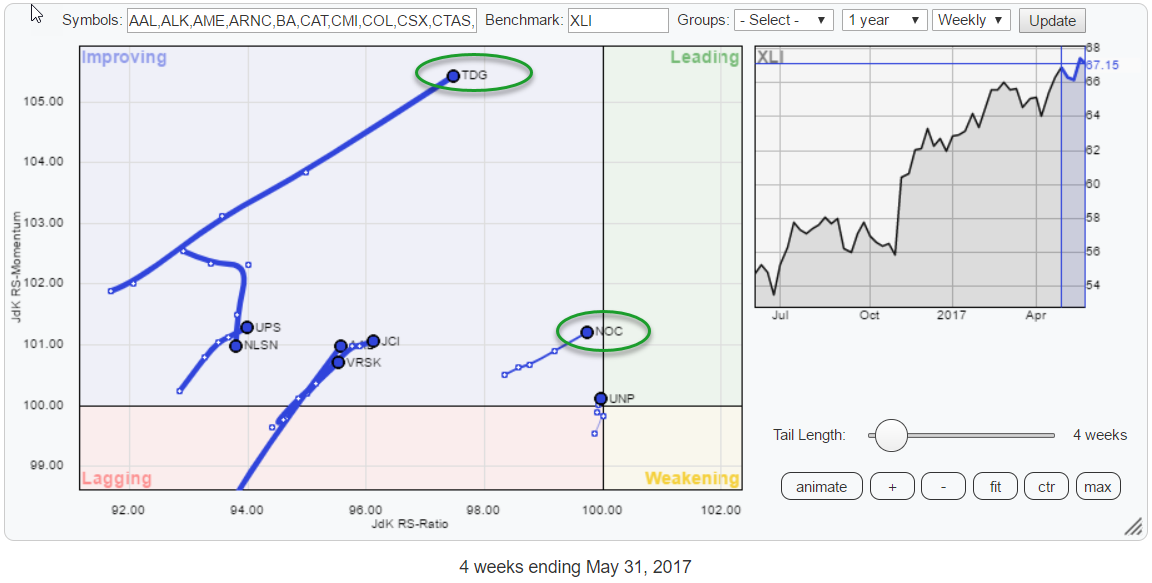 Inside the improving quadrant, there are a few stocks at positive RRG-Headings. Obviously, TDG stands out with its long tail which is almost a straight line. The other stock that caught my attention is NOC as it is closer to 100 on the RS-Ratio axis and not as high as TDG yet on the RS-Momentum axis, but at a strong RRG-Heading suggesting that a bit more positive momentum could be in store.
Inside the improving quadrant, there are a few stocks at positive RRG-Headings. Obviously, TDG stands out with its long tail which is almost a straight line. The other stock that caught my attention is NOC as it is closer to 100 on the RS-Ratio axis and not as high as TDG yet on the RS-Momentum axis, but at a strong RRG-Heading suggesting that a bit more positive momentum could be in store.
After studying both stocks on the respective price charts, I decided to show NOC here as TDG seems to be at risk of getting "tired" soon which makes reaching the leading quadrant doubtful.
Disclaimer: My first flight in a fighter jet was in an NF5 "Freedom Fighter." This may have impacted the decision to go for the chart of NOC ;)
Northrop Grumman Corp. - NOC
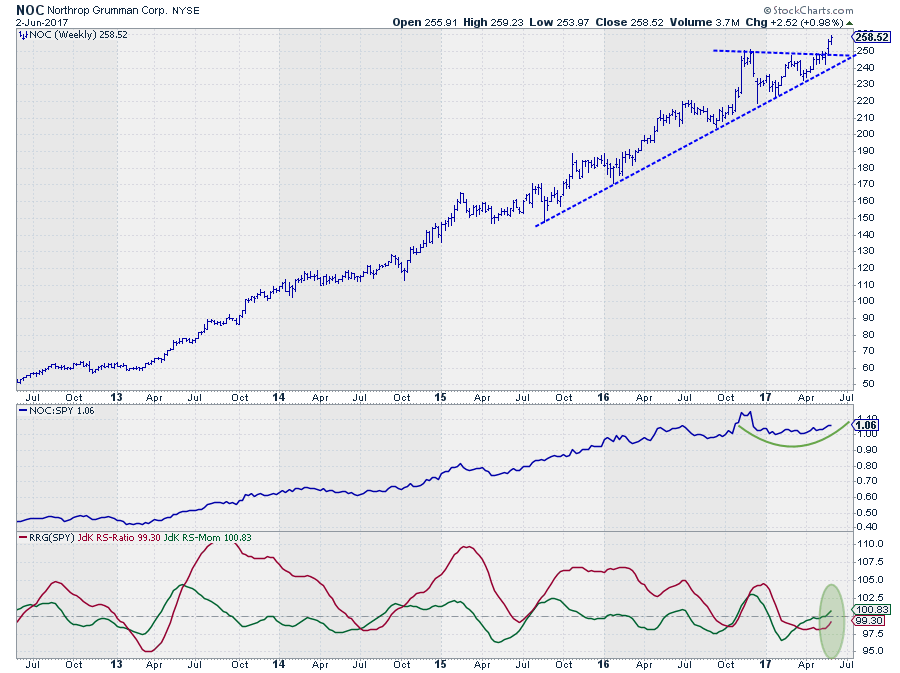 One of the characteristics of the NF-5 with its twin engine was that it could fly straight up without banking to either side when the air got so thin that the jet engines could not provide enough trust anymore to continue rising.
One of the characteristics of the NF-5 with its twin engine was that it could fly straight up without banking to either side when the air got so thin that the jet engines could not provide enough trust anymore to continue rising.
The chart of NOC looks similar. The uptrend in price is almost perfect over the past five years. A bit of thin air towards the end of 2016 and into 2017 prevented NOC from pushing much higher but the stock did not bank away from its flight path. The nose kept on pointing in the right direction and managed to find renewed upward thrust last April pushing NOC above its previous high, confirming that the trend is still intact.
The RS-Line only recently started to pick up strength again, resulting in the JdK RS-Momentum line crossing above the 100-level a few weeks ago and RS-Ratio seems to be getting back to life again.
With the price at new highs in a confirmed uptrend and NOC approaching the leading quadrant on the Relative Rotation Graph, it is definitely a stock worthwhile keeping an eye on for overweight or long positions.
Stocks leading the sector
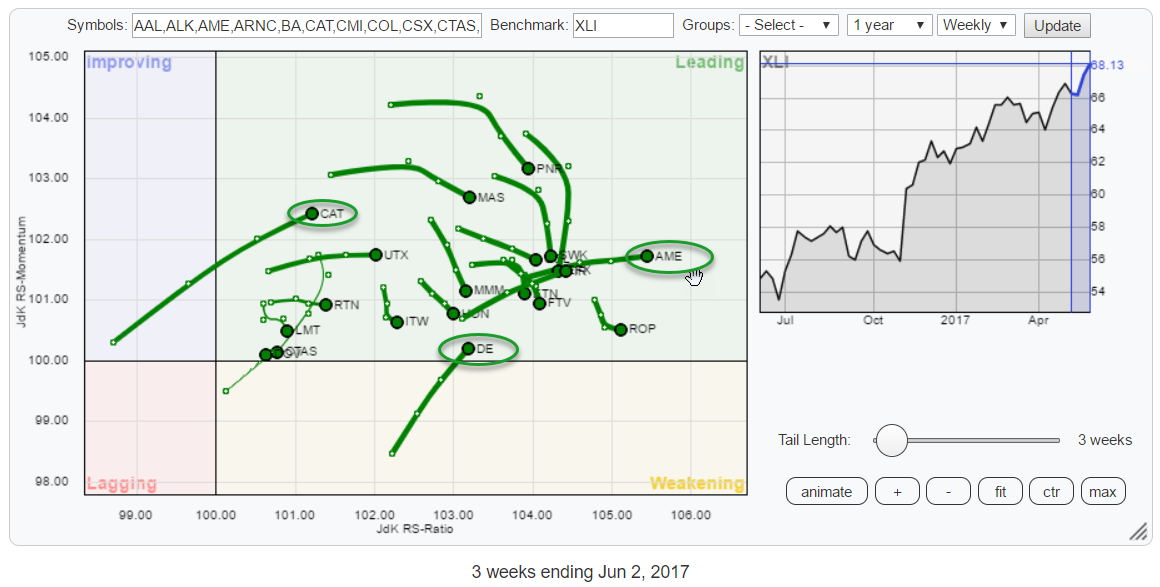 Zooming in on the leading quadrant shows the stocks that are in established relative uptrends and therefore are leading the sector.
Zooming in on the leading quadrant shows the stocks that are in established relative uptrends and therefore are leading the sector.
On the chart above three stocks stand out. They are AME which is furthest to the right and therefore in the longest and strongest relative uptrend. And although AME still looks good it might be smarter to look for opportunities in stocks that still have room, or more room, for upside potential.
CAT and DE seem to fulfill that criterion. CAT has just crossed over into the leading quadrant from improving showing a long/strong tail, while DE has just crossed back into the leading quadrant after completing a rotation through weakening.
Caterpillar Inc. - CAT
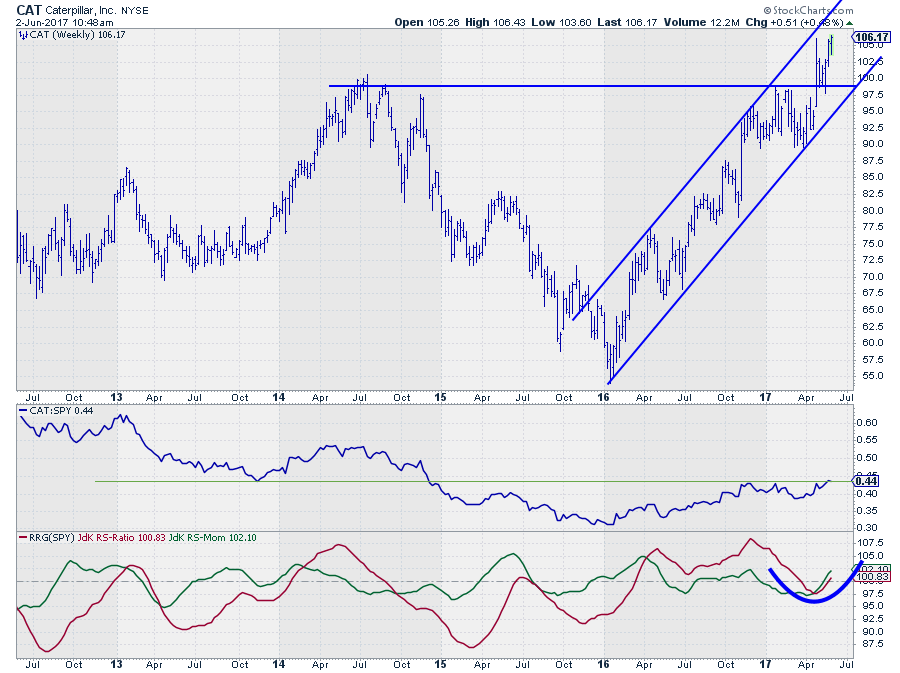 Breaking resistance between $ 97,50 - $ 100 opened up new upward potential in price for Caterpillar. The uptrend out of the early 2016 low is fully intact, and within the boundaries of the channel, there is now even enough room for correction without harming the trend in the near future.
Breaking resistance between $ 97,50 - $ 100 opened up new upward potential in price for Caterpillar. The uptrend out of the early 2016 low is fully intact, and within the boundaries of the channel, there is now even enough room for correction without harming the trend in the near future.
A brief pause and decline in relative strength during the first few months of this year have caused CAT to complete a rotation through all quadrants. But relative strength is back now with both RRG-Lines above 100 and supported by the upward break in price.
CAT remains a good choice in the industrials section of any portfolio.
Deere & Co. - DE
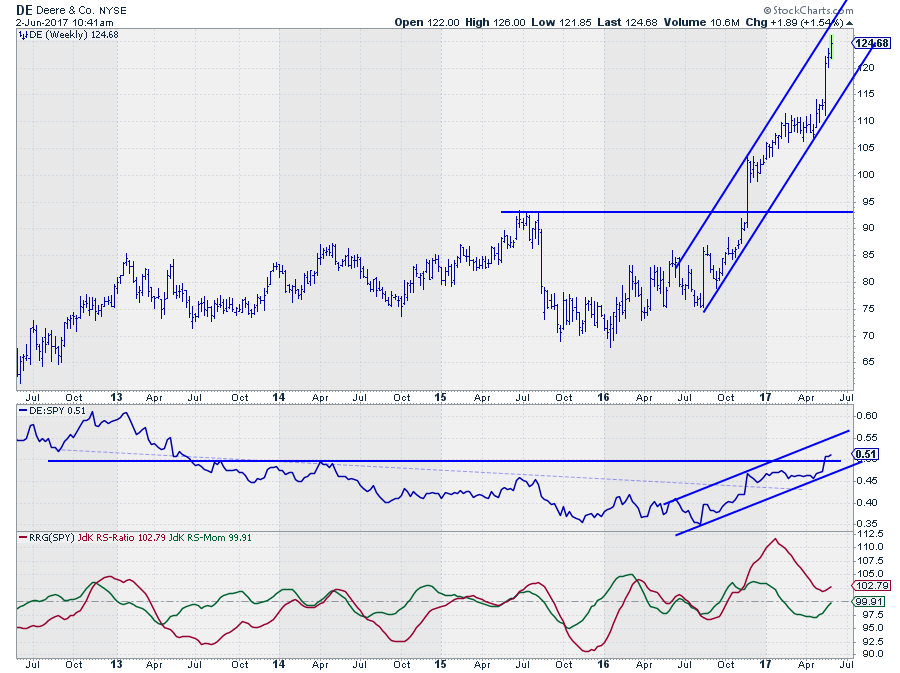 The second stock inside the leading quadrant that I want to highlight is Deere & Co. The price already broke to new highs at the end of last year and continued strongly higher. Very recently a small sideways move in price (you really have to watch carefully to catch it on the chart) has set a new low/support level marking the lower boundary of the rising channel before shooting off again.
The second stock inside the leading quadrant that I want to highlight is Deere & Co. The price already broke to new highs at the end of last year and continued strongly higher. Very recently a small sideways move in price (you really have to watch carefully to catch it on the chart) has set a new low/support level marking the lower boundary of the rising channel before shooting off again.
From a price perspective, things are looking good and there are no signs of a change in the near future.
The relative charts are confirming the strength for DE. The RS-Line just broke above a major overhead resistance level and has now plenty of room to maneuver higher. The positions of the RRG-Lines are causing a rotation from weakening back into leading at a positive RRG-Heading which is a strong sign.
Julius de Kempenaer | RRG Research
RRG, Relative Rotation Graphs, JdK RS-Ratio, and JdK RS-Momentum are registered TradeMarks by RRG Research
Follow RRG Research on social media:
If you want to discuss RRG with me on SCAN, please use my handle Julius_RRG so that I will get a notification






